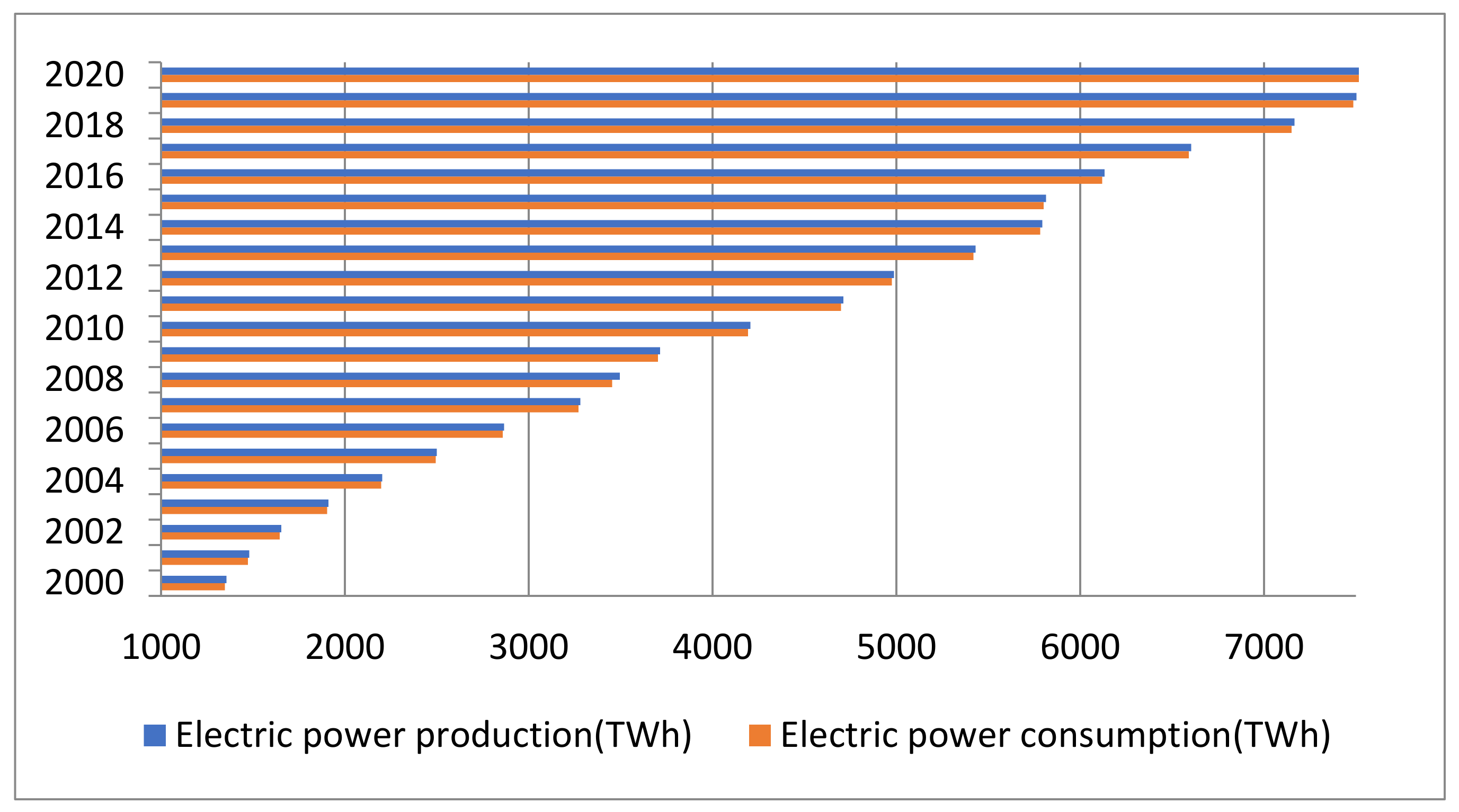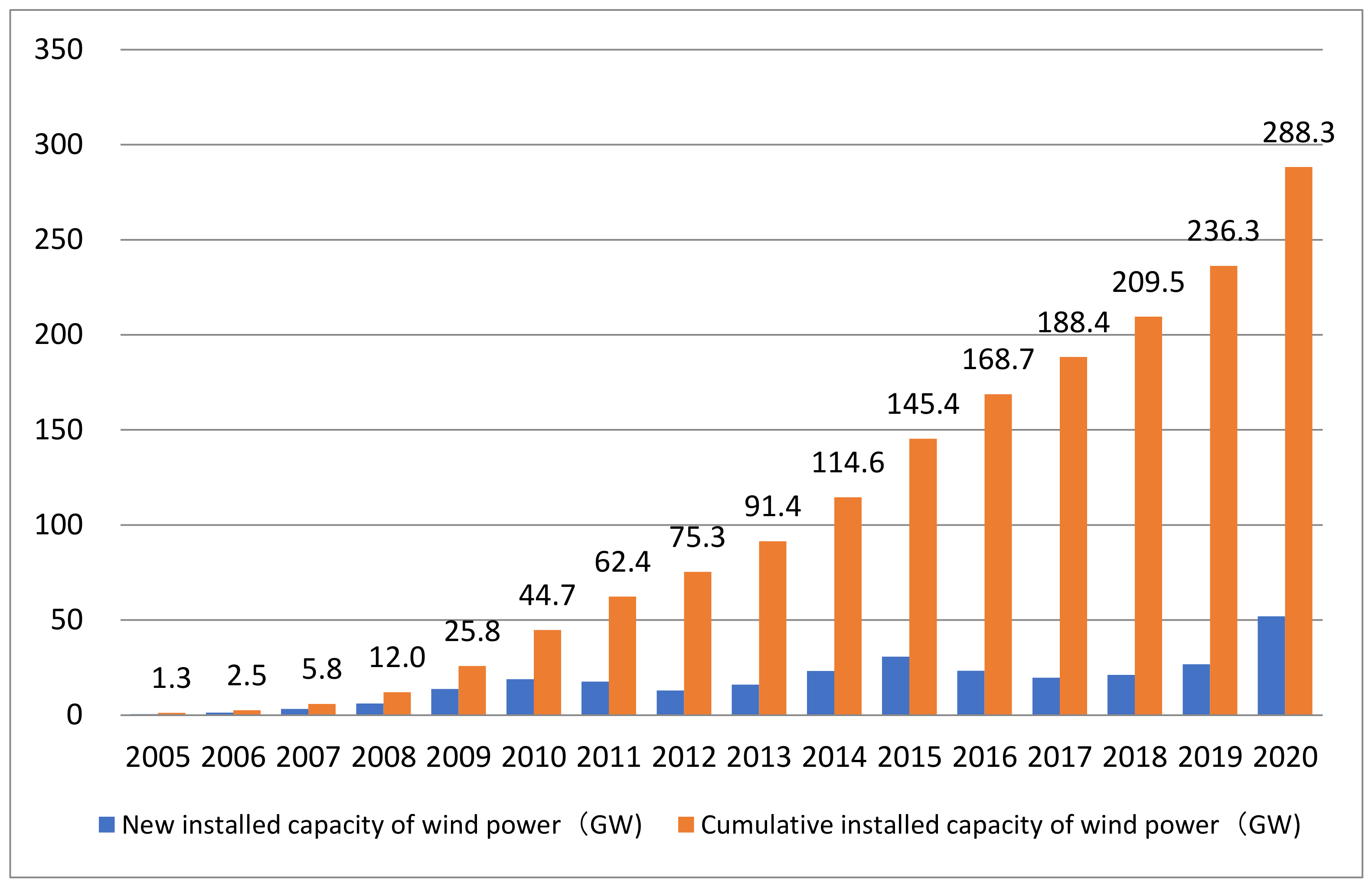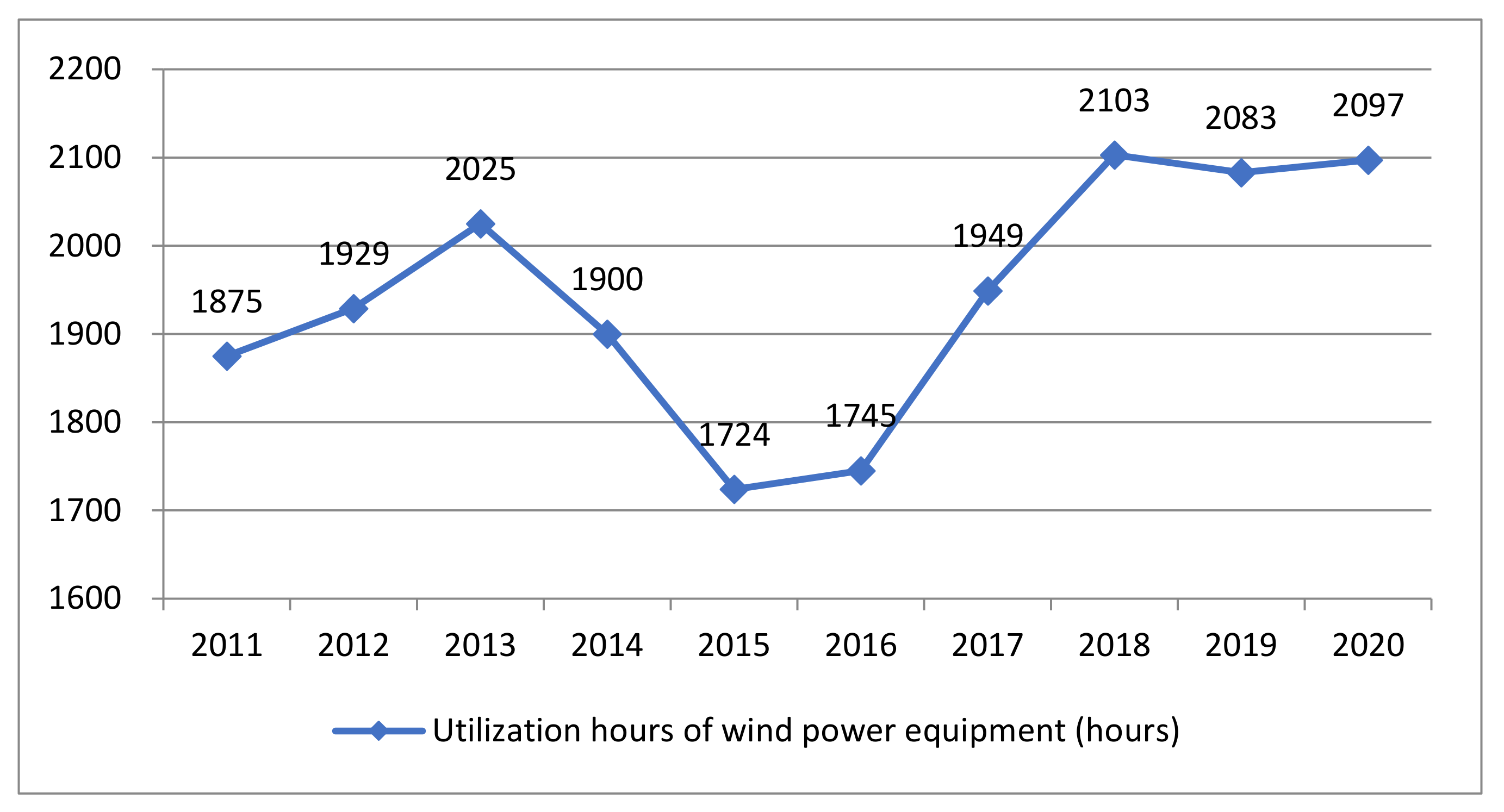Status Quo, Development and Utilization Efficiencies of Wind Power in China
Abstract
:1. Introduction
2. Overview of China’s Power Production
3. Status Quo of Wind Power in China
3.1. Potential of Wind Energy Resources in China
3.2. Changes in Newly Added and Accumulated Installed Wind Power Capacity
3.3. Status Quo and Historical Trend of Wind Power
3.3.1. Status Quo of Wind Power in China
3.3.2. Historical Trend of Wind Power in China
3.3.3. Wind Power Utilization in China
4. Development and Utilization Efficiency of Wind Power in China
4.1. Method
4.2. Index Selection
4.2.1. Principle of Index Selection
4.2.2. Index Selection of Wind Power Development Efficiency
4.2.3. Index Selection of Wind Power Utilization Efficiency
4.3. Measurement and Analysis of China’s Wind Power Development Efficiency
4.3.1. Measurement of China’s Wind Power Development Efficiency
4.3.2. Results Analysis
4.4. Measurement and Analysis of China’s Wind Power Utilization Efficiency
4.4.1. Measurement of China’s Wind Power Utilization Efficiency
4.4.2. Results Analysis
5. Conclusions
Author Contributions
Funding
Institutional Review Board Statement
Informed Consent Statement
Data Availability Statement
Acknowledgments
Conflicts of Interest
References
- Rodríguez, X.A.; Regueiro, R.M.; Doldán, X.R. Analysis of productivity in the Spanish wind industry. Renew. Sustain. Energy Rev. 2019, 118, 109573. [Google Scholar] [CrossRef]
- Papież, M.; Śmiech, S.; Frodyma, K. Factors affecting the efficiency of wind power in the European Union countries. Energy Policy 2019, 132, 965–977. [Google Scholar] [CrossRef]
- Zhong, K.L.; Zhao, W.H.; Tan, Z.F.; Ye, D. A System Dynamics Simulation for Wind Power Performance Evaluation. Power Syst. Clean Energy 2018, 5, 61–68. [Google Scholar]
- Gao, M. Research on China’s provincial energy efficiency based on DDF function and meta frontier model. Stat. Decis. Mak. 2016, 1, 146–150. [Google Scholar]
- Shen, X.C.; Lyu, S.J. Wind power development, government regulation structure, and vested interest groups: Analysis based on panel data of Province of China. Energy Policy 2019, 128, 487–494. [Google Scholar] [CrossRef]
- Yao, J.; Zhu, Y. Research on the main factors affecting the development and utilization of wind energy in Jilin Province, China. J. Renew. Sustain. Energy 2019, 11, 015904. [Google Scholar] [CrossRef]
- Lv, W.C.; Ma, J.L.; Chen, J.X.; Wu, Y.Q. Current situation and restriction bottleneck of the development of wind power in-dustry. Renew. Energy Resour. 2018, 8, 1214–1218. [Google Scholar]
- Jenniches, S.; Worrell, E.; Fumagalli, E.M. Regional economic and environmental impacts of wind power developments: A case study of a German region. Energy Policy 2019, 132, 499–514. [Google Scholar] [CrossRef]
- Xia, F.; Song, F. Evaluating the economic impact of wind power development on local economies in China. Energy Policy 2017, 110, 263–270. [Google Scholar] [CrossRef]
- Charnes, A.; Cooper, W.W.; Rhodes, E. Measuring the efficiency of decision making units. Eur. J. Oper. Res. 1978, 2, 429–444. [Google Scholar] [CrossRef]
- Zhao, L.; Wang, L.; Yao, S.L.; Zhang, Y. Evaluation and analysis of hospital efficiency in China based on macro- and mi-cro-level analyses. J. Publ. Health Theory Pract. 2020, 28, 191–197. [Google Scholar]
- Chen, Y.; Xu, J.-T. An assessment of energy efficiency based on environmental constraints and its influencing factors in China. Environ. Sci. Pollut. Res. 2019, 26, 16887–16900. [Google Scholar] [CrossRef] [PubMed]
- Liu, X.; Zhu, Q.; Chu, J.; Ji, X.; Li, X. Environmental Performance and Benchmarking Information for Coal-Fired Power Plants in China: A DEA Approach. Comput. Econ. 2016, 54, 1287–1302. [Google Scholar] [CrossRef]
- Liu, X.; Wu, J. Energy and environmental efficiency analysis of China’s regional transportation sectors: A slack-based DEA approach. Energy Syst. 2015, 8, 747–759. [Google Scholar] [CrossRef]
- Lozano, S. Technical and environmental efficiency of a two-stage production and abatement system. Ann. Oper. Res. 2015, 255, 199–219. [Google Scholar] [CrossRef]
- Yao, J.; Zhu, Y. Measurement and Analysis of the Development and Utilization Efficiency of Wind Energy in Jilin Province. IOP Conf. Ser: Earth Environ. Sci. 2019, 237, 042011. [Google Scholar] [CrossRef]
- BP. Statistical Review of World Energy. 2021. Available online: https://www.bp.com/en/global/corporate/energy-economics/statistical-review-of-world-energy.html (accessed on 5 November 2021).
- Global Power Report 2018—Analysis of Energy Structure in Various Countries. Available online: https://www.sohu.com/a/284616918_131990 (accessed on 8 November 2021).
- Analysis on the Current Situation and Future Development Trend of China’s Wind Power Industry in 2017. Available online: https://www.chyxx.com/industry/201708/548371.html (accessed on 8 November 2021).





| Year | Hydropower | Thermal Power | Nuclear Power | Wind Power | Solar Power |
|---|---|---|---|---|---|
| 2011 | 14.83% | 81.34% | 1.83% | 1.49% | 0.82% |
| 2012 | 17.49% | 78.05% | 1.95% | 1.92% | 0.50% |
| 2013 | 16.94% | 78.19% | 2.05% | 2.60% | 0.59% |
| 2014 | 18.84% | 75.56% | 2.35% | 2.76% | 0.21% |
| 2015 | 19.44% | 73.68% | 2.94% | 3.19% | 0.50% |
| 2016 | 19.43% | 72.24% | 3.47% | 3.86% | 0.75% |
| 2017 | 18.51% | 71.10% | 3.84% | 4.72% | 1.83% |
| 2018 | 17.61% | 70.41% | 4.22% | 5.23% | 2.53% |
| 2019 | 17.77% | 68.88% | 4.76% | 5.53% | 3.05% |
| 2020 | 17.77% | 67.88% | 4.80% | 6.12% | 3.42% |
| Country | 2012 | 2013 | 2014 | 2015 | 2016 | 2017 | 2018 | 2019 | 2020 |
|---|---|---|---|---|---|---|---|---|---|
| China | 19.41% | 21.76% | 22.64% | 22.32% | 25.04% | 26.71% | 28.81% | 28.58% | 29.32% |
| U.S.A | 26.81% | 26.68% | 26.00% | 23.17% | 23.83% | 22.53% | 21.69% | 21.08% | 21.42% |
| Germany | 9.74% | 8.30% | 8.29% | 9.70% | 8.31% | 9.27% | 8.66% | 8.88% | 8.23% |
| U.K. | 3.74% | 4.47% | 4.53% | 4.84% | 3.87% | 4.35% | 4.48% | 4.53% | 4.75% |
| India | 5.17% | 4.72% | 4.74% | 3.94% | 4.52% | 4.62% | 4.75% | 4.46% | 3.80% |
| Spain | 9.32% | 8.78% | 7.37% | 5.93% | 5.08% | 4.31% | 4.01% | 3.74% | 3.34% |
| Total | 74.19% | 74.70% | 73.56% | 69.91% | 70.64% | 71.78% | 72.41% | 71.27% | 70.86% |
| Year | Input Index (Cumulative Installed Capacity of Wind Power (MW)) | Output Index (Wind Power Generation Capacity (TWh)) |
|---|---|---|
| 2005 | 1250 | 1.6 |
| 2006 | 2537 | 2.8 |
| 2007 | 5848 | 5.7 |
| 2008 | 12,002 | 13.1 |
| 2009 | 25,805 | 27.6 |
| 2010 | 44,734 | 44.6 |
| 2011 | 62,364 | 70.3 |
| 2012 | 75,324 | 96.0 |
| 2013 | 91,413 | 141.2 |
| 2014 | 114,609 | 156.1 |
| 2015 | 145,360 | 185.8 |
| 2016 | 168,730 | 237.1 |
| 2017 | 188,392 | 304.6 |
| 2018 | 209,534 | 365.8 |
| 2019 | 236,320 | 405.7 |
| 2020 | 288,320 | 466.5 |
| Year | Input Index (Windpower Generation Capacity (TWh)) | Output Index (Proportion of Wind Power Generation to the Total (%)) |
|---|---|---|
| 2005 | 1.6 | 0.06 |
| 2006 | 2.8 | 0.10 |
| 2007 | 5.7 | 0.17 |
| 2008 | 13.1 | 0.38 |
| 2009 | 27.6 | 0.75 |
| 2010 | 44.6 | 1.06 |
| 2011 | 70.3 | 1.49 |
| 2012 | 96.0 | 1.92 |
| 2013 | 141.2 | 2.60 |
| 2014 | 156.1 | 2.76 |
| 2015 | 185.8 | 3.20 |
| 2016 | 237.1 | 3.86 |
| 2017 | 304.6 | 4.72 |
| 2018 | 365.8 | 5.23 |
| 2019 | 405.7 | 5.54 |
| 2020 | 466.5 | 6.12 |
| DMU | Crste | Vrste | Scale | Trend |
|---|---|---|---|---|
| 2005 | 0.733 | 1 | 0.733 | IRS |
| 2006 | 0.632 | 0.727 | 0.869 | IRS |
| 2007 | 0.558 | 0.591 | 0.944 | IRS |
| 2008 | 0.625 | 0.642 | 0.974 | IRS |
| 2009 | 0.613 | 0.62 | 0.989 | IRS |
| 2010 | 0.571 | 0.574 | 0.994 | IRS |
| 2011 | 0.646 | 0.648 | 0.996 | IRS |
| 2012 | 0.73 | 0.732 | 0.997 | IRS |
| 2013 | 0.885 | 0.887 | 0.998 | IRS |
| 2014 | 0.78 | 0.781 | 0.999 | IRS |
| 2015 | 0.732 | 0.733 | 0.999 | IRS |
| 2016 | 0.805 | 0.805 | 1 | - |
| 2017 | 0.926 | 0.926 | 1 | - |
| 2018 | 1 | 1 | 1 | - |
| 2019 | 0.983 | 1 | 0.983 | DRS |
| 2020 | 0.927 | 1 | 0.927 | DRS |
| Mean | 0.759 | 0.792 | 0.963 |
| DMU | Crste | Vrste | Scale | Trend |
|---|---|---|---|---|
| 2005 | 1 | 1 | 1 | - |
| 2006 | 0.952 | 1 | 0.952 | DRS |
| 2007 | 0.795 | 0.951 | 0.837 | DRS |
| 2008 | 0.774 | 1 | 0.774 | DRS |
| 2009 | 0.725 | 1 | 0.725 | DRS |
| 2010 | 0.634 | 1 | 0.634 | DRS |
| 2011 | 0.565 | 1 | 0.565 | DRS |
| 2012 | 0.533 | 1 | 0.533 | DRS |
| 2013 | 0.491 | 1 | 0.491 | DRS |
| 2014 | 0.471 | 0.986 | 0.478 | DRS |
| 2015 | 0.459 | 1 | 0.459 | DRS |
| 2016 | 0.434 | 1 | 0.434 | DRS |
| 2017 | 0.413 | 1 | 0.413 | DRS |
| 2018 | 0.381 | 1 | 0.381 | DRS |
| 2019 | 0.364 | 1 | 0.364 | DRS |
| 2020 | 0.350 | 1 | 0.350 | DRS |
| Mean | 0.584 | 0.996 | 0.587 |
Publisher’s Note: MDPI stays neutral with regard to jurisdictional claims in published maps and institutional affiliations. |
© 2021 by the authors. Licensee MDPI, Basel, Switzerland. This article is an open access article distributed under the terms and conditions of the Creative Commons Attribution (CC BY) license (https://creativecommons.org/licenses/by/4.0/).
Share and Cite
Yao, J.; Yao, F. Status Quo, Development and Utilization Efficiencies of Wind Power in China. Processes 2021, 9, 2133. https://doi.org/10.3390/pr9122133
Yao J, Yao F. Status Quo, Development and Utilization Efficiencies of Wind Power in China. Processes. 2021; 9(12):2133. https://doi.org/10.3390/pr9122133
Chicago/Turabian StyleYao, Jie, and Fang Yao. 2021. "Status Quo, Development and Utilization Efficiencies of Wind Power in China" Processes 9, no. 12: 2133. https://doi.org/10.3390/pr9122133
APA StyleYao, J., & Yao, F. (2021). Status Quo, Development and Utilization Efficiencies of Wind Power in China. Processes, 9(12), 2133. https://doi.org/10.3390/pr9122133





